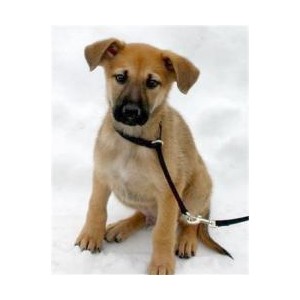The Chinook is a sled dog, but it doesn't look like a normal sled dog, at least in my opinion. A man named Arthur Treadwell Walden, who lived in Wonalancet, New Hampshire, bred a husky-type bitch to a mastiff-type dog in 1917, and one of the puppies seemed like he would make an especially good sled dog. This dog was named Chinook, and he is the main stud dog that the whole Chinook breed came from.
Mr. Walden bred Chinook to Belgian Sheepdogs, German Shepherd Dogs, Canadian Eskimo Dogs, and maybe some other breeds. Then he bred Chinook's puppies back to him. Pretty soon, Mr. Walden had a bunch of dogs with similar looks, and they were all good at pulling sleds.
In 1927, when Richard E. Byrd starting planning an expedition in Antarctica, Arthur Walden applied to go along, even though he was 56 years old, which was over the maximum age. But he got accepted because of his experience with dog sledding, and he trained all the dogs that were being used on the expedition. It took over a year for the team to do all the training and test all of their equipment.
I am sorry to tell you that during the expedition, Chinook disappeared on January 17, 1929, which was his 12th birthday. No one knew whether he had an accident or just went off to die or what. His body was never found. The news of his death got printed in newspapers all over the world, and back in New Hampshire, the people named the road between the towns of Tamworth and Wonalancet "Chinook Trail."
But anyway, getting back to the Chinook breed, after Arthur Walden's death, his breeding stock went to Julia Lombard, and then on to Perry Greene in the late 1940s. Mr. Greene continued breeding Chinooks for many years until his death in 1963. Since he was really the only person breeding these dogs, there soon got to be very few of them left. In fact, by 1981 only eleven breedable Chinooks were still around. Breeders in Maine, Ohio, and California divided the dogs that were left and managed to save the Chinooks from extinction.
In 1991, the Chinook breed got registered status with the UKC, but there still aren't very many of these dogs around, like maybe only about 800. Every year 100 or so puppies are born worldwide. The UKC registry allows breeders to cross-breed to other types of dogs that were likely used to create the Chinook breed in the first place. Then every 4th-generation dog that is back-crossed can be registered, but it has to meet the breed standards.
Chinooks have been in the AKC Foundation Stock Service since 2001, and they were added to the Miscellaneous Class in 2010. This month the Chinook became the 176th AKC breed, and it is part of the Working Class. Also, the Chinook is the State Dog of New Hampshire.
The double coat of the Chinook is a light honey to reddish-gold color. If there are black markings on the ears, muzzle, and eye corners, that is especially good. Buff markings are okay, but white markings are not allowed. Chinooks are between 21" and 27" in height, and they weigh 55 to 90 pounds. They are balanced and muscular. They can have either prick ears or drop ears, but drop ears are preferred.
Chinooks make really good family dogs because they are playful and affectionate, and they love children. They don't need a ton of exercise, but a daily walk is good. If you don't have a sled for them to pull, you can use them for carting, flyball, agility, skijoring, or search-and-rescue. You should not leave them outside in your yard all the time, because Chinooks want to be inside with their humans.
Since they were bred to be part of a team, Chinooks get along well with other dogs. They are smart and easy to train. They don't make good guard dogs, so if you want a dog for protection, you should get a different breed.
Okay, well, that's about all I know to tell you about the Chinook breed. I just wish those silly men hadn't gone on that expedition to Antarctica, because I hate to think of poor Chinook dying out there, all alone in the cold.













